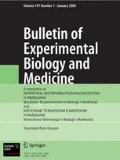The study examined association between oscillations of body temperature of laboratory Wistar rats maintained under constant illumination with the amplitude of fluctuations of secondary cosmic rays reported by neutron count rate provided by neutron monitors and geomagnetic undulations. In contrast to geomagnetic undulations, neutron count rate variations and body temperature oscillations in rats assessed by spectrum analysis of the corresponding step functions at 1-min intervals demonstrated almost permanent variations with the periods ranging from 100 to 400 min. Under conditions of constant illumination inducing changes in the period of circadian rhythm and predominance of the ultradian rhythms, an association between neutron count rate fluctuations and body temperature oscillations was observed perpetually during the day- and nighttime.
Similar content being viewed by others
References
Deshcherevskii AV, Sidorin AYa, Kharin EP. Influence of heliogeophysical factors on animal activity under laboratory conditions. Dokl. Biol. Sci. 2005;401(1-6):139-143. doi: https://doi.org/10.1007/s10630-005-0067-0
Diatroptov ME, Panchelyuga VA, Panchelyuga MS, Surov AV. Circahoralian Rhythms of Body Temperature in Mammals and Birds with Different Metabolism Levels. Dokl. Biol. Sci. 2020;494(1):228-231. doi: https://doi.org/10.1134/S0012496620050038
Diatroptov ME, Yagova NV, Petrovsky DV, Surov AV. Association between Rhythmic Variations of Mouse Body Temperature with 4-16-minute Periods and Geomagnetic Undulations in Corresponding Frequency Range Pc5/Pi3. Bull. Exp. Biol. Med. 2021;171(5):661-665. doi: https://doi.org/10.1007/s10517-021-05289-y
Dorman LI, Libin IV. Short-period variations in cosmic-ray intensity. Soviet Physics Uspekhi. 1985;28(3):233-256.
Zenchenko ТА, Medvedeva AA, Khorseva NI, Breus ТK. Synchronization of heart rate indices of human and geomagnetic field variations in the frequency range of 0.5-3.0 MHz. Geofiz. Protsessy Biosfera. 2013;12(4):73-84. Russian.
Blessing W, Ootsuka Y. Timing of activities of daily life is jaggy: How episodic ultradian changes in body and brain temperature are integrated into this process. Temperature (Austin). 2016;3(3):371-383. doi: https://doi.org/10.1080/23328940.2016.1177159
Blum ID, Zhu L, Moquin L, Kokoeva MV, Gratton A, Giros B, Storch KF. A highly tunable dopaminergic oscillator generates ultradian rhythms of behavioral arousal. Elife. 2014;3:e05105. doi: https://doi.org/10.7554/eLife.05105
Bourguignon C, Storch KF. Control of Rest: Activity by a Dopaminergic Ultradian Oscillator and the Circadian Clock. Front. Neurol. 2017;8:614. doi: https://doi.org/10.3389/fneur.2017.00614
Crevecoeur F, Bollens B, Detrembleur C, Lejeune TM. Towards a “gold-standard” approach to address the presence of long-range auto-correlation in physiological time series. J. Neurosci. Methods. 2010;192(1):163-172. doi: https://doi.org/10.1016/j.jneumeth.2010.07.017
Goh GH, Maloney SK, Mark PJ, Blache D. Episodic Ultradian Events-Ultradian Rhythms. Biology (Basel). 2019;8(1):15. doi: https://doi.org/10.3390/biology8010015
Khabarova OV, Dimitrova S. On the nature of people’s reaction to space weather and meteorological weather changes. Sun. Geosph. 2009;4(2):60-71.
McCraty R, Atkinson M, Stolc V, Alabdulgader AA, Vainoras A, Ragulskis M. Synchronization of Human Autonomic Nervous System Rhythms with Geomagnetic Activity in Human Subjects. Int. J. Environ. Res. Public Health. 2017;14(7):770. doi: https://doi.org/10.3390/ijerph14070770
McCraty R, Deyhle A, Childre D. The global coherence initiative: creating a coherent planetary standing wave. Glob. Adv. Health Med. 2012;1(1):64-77. doi: https://doi.org/10.7453/gahmj.2012.1.1.013
Monto S, Palva S, Voipio J, Palva JM. Very slow EEG fluctuations predict the dynamics of stimulus detection and oscillation amplitudes in humans. J. Neurosci. 2008;28(33):8268-8272. doi: https://doi.org/10.1523/JNEUROSCI.1910-08.2008
Palmer SJ, Rycroft MJ, Cermack M. Solar and geomagnetic activity, extremely low frequency magnetic and electric fields and human health at the Earth’s surface. Surv. Geophys. 2006;27(5):557-595. doi: https://doi.org/10.1007/s10712-006-9010-7
Author information
Authors and Affiliations
Corresponding author
Additional information
Translated from Byulleten’ Eksperimental’noi Biologii i Meditsiny, Vol. 172, No. 7, pp. 125-131, July, 2021
Rights and permissions
About this article
Cite this article
Diatroptova, M.A., Diatroptov, M.E. Amplitude of One-Minute Fluctuations of Secondary Cosmic Rays as a Marker of Environmental Factor Determining Ultradian Rhythms in Body Temperature of Laboratory Rats. Bull Exp Biol Med 172, 105–110 (2021). https://doi.org/10.1007/s10517-021-05341-x
Received:
Published:
Issue Date:
DOI: https://doi.org/10.1007/s10517-021-05341-x




